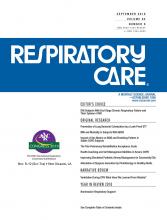Review Article2018 Year in Review
2018 Year in Review: Noninvasive Respiratory Support
John D Davies
Respiratory Care September 2019, 64 (9) 1139-1145; DOI: https://doi.org/10.4187/respcare.07170
John D Davies
Duke University Health System, Durham, North Carolina.

References
- 1.↵
- Mokart D,
- Pastores SM,
- Darmon M
- 2.↵
- Azoulay E,
- Mokart D,
- Pène F,
- Lambert J,
- Kouatchet A,
- Mayaux J,
- et al
- 3.↵
- Azoulay E,
- Lemiale V,
- Mokart D,
- Nseir S,
- Argaud L,
- Pène F,
- et al
- 4.↵
- Sklar MC,
- Mohammed A,
- Orchanian-Cheff A,
- Del Sorbo L,
- Mehta S,
- Munshi L
- 5.↵
- Baillard C,
- Prat G,
- Jung B,
- Futier E,
- Lefrant JY,
- Vincent F,
- et al
- 6.↵
- 7.↵
- Frat JP,
- Ragot S,
- Coudroy R,
- Constantin JM,
- Girault C,
- Prat G,
- et al
- 8.↵
- Rochwerg B,
- Brochard L,
- Elliott MW,
- Hess DR,
- Hill NS,
- Nava S,
- et al
- 9.↵
- Perkins GD,
- Mistry D,
- Gates S,
- Gao F,
- Snelson C,
- Hart N,
- et al
- 10.↵
- Lamb KD,
- Spilman SK,
- Oetting TW,
- Jackson JA,
- Trump MW,
- Sahr SM
- 11.↵
- Spoletini G,
- Mega C,
- Pisani L,
- Alotaibi M,
- Khoja A,
- Price LL,
- et al
- 12.↵
- 13.↵
- Patel BK,
- Wolfe KS,
- MacKenzie EL,
- Salem D,
- Esbrook CL,
- Pawlik AJ,
- et al
- 14.↵
- Zorc JJ,
- Hall CB
- 15.↵
- 16.↵
- Drescher GS,
- Hughes CW
- 17.↵
- Cheema B,
- Welzel T,
- Rossouw B
In this issue
Respiratory Care
Vol. 64, Issue 9
1 Sep 2019
2018 Year in Review: Noninvasive Respiratory Support
John D Davies
Respiratory Care Sep 2019, 64 (9) 1139-1145; DOI: 10.4187/respcare.07170
Jump to section
- Article
- Abstract
- Introduction
- Noninvasive Respiratory Support for the Subject Who Is Immunocompromised
- Use of NIV for Preoxygenation Before Endotracheal Intubation
- Noninvasive Respiratory Support in Subjects With Hypoxemic Respiratory Failure
- Noninvasive Respiratory Support and Weaning
- Noninvasive Respiratory Support in Subjects Who Are Critically Ill
- Noninvasive Respiratory Support in Subjects With ARDS
- Noninvasive Respiratory Support in the Neonatal and Pediatric Population
- Summary
- Footnotes
- References
- Figures & Data
- Info & Metrics
- References






